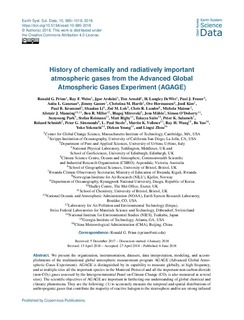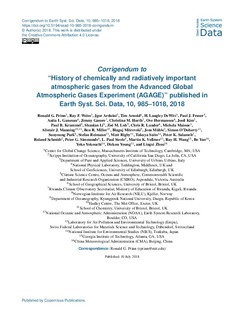| dc.description.abstract | We present the organization, instrumentation, datasets, data interpretation, modeling, and accomplishments of the multinational global atmospheric measurement program AGAGE (Advanced Global Atmospheric Gases Experiment). AGAGE is distinguished by its capability to measure globally, at high frequency, and at multiple sites all the important species in the Montreal Protocol and all the important non-carbon-dioxide (non-CO2) gases assessed by the Intergovernmental Panel on Climate Change (CO2 is also measured at several sites). The scientific objectives of AGAGE are important in furthering our understanding of global chemical and climatic phenomena. They are the following: (1) to accurately measure the temporal and spatial distributions of anthropogenic gases that contribute the majority of reactive halogen to the stratosphere and/or are strong infrared absorbers (chlorocarbons, chlorofluorocarbons – CFCs, bromocarbons, hydrochlorofluorocarbons – HCFCs, hydrofluorocarbons – HFCs and polyfluorinated compounds (perfluorocarbons – PFCs), nitrogen trifluoride – NF3, sulfuryl fluoride – SO2F2, and sulfur hexafluoride – SF6) and use these measurements to determine the global rates of their emission and/or destruction (i.e., lifetimes); (2) to accurately measure the global distributions and temporal behaviors and determine the sources and sinks of non-CO2 biogenic–anthropogenic gases important to climate change and/or ozone depletion (methane – CH4, nitrous oxide – N2O, carbon monoxide – CO, molecular hydrogen – H2, methyl chloride – CH3Cl, and methyl bromide – CH3Br); (3) to identify new long-lived greenhouse and ozone-depleting gases (e.g., SO2F2, NF3, heavy PFCs (C4F10, C5F12, C6F14, C7F16, and C8F18) and hydrofluoroolefins (HFOs; e.g., CH2 = CFCF3) have been identified in AGAGE), initiate the real-time monitoring of these new gases, and reconstruct their past histories from AGAGE, air archive, and firn air measurements; (4) to determine the average concentrations and trends of tropospheric hydroxyl radicals (OH) from the rates of destruction of atmospheric trichloroethane (CH3CCl3), HFCs, and HCFCs and estimates of their emissions; (5) to determine from atmospheric observations and estimates of their destruction rates the magnitudes and distributions by region of surface sources and sinks of all measured gases; (6) to provide accurate data on the global accumulation of many of these trace gases that are used to test the synoptic-, regional-, and global-scale circulations predicted by three-dimensional models; and (7) to provide global and regional measurements of methane, carbon monoxide, and molecular hydrogen and estimates of hydroxyl levels to test primary atmospheric oxidation pathways at midlatitudes and the tropics. Network Information and Data Repository: http://agage.mit.edu/data or http://cdiac.ess-dive.lbl.gov/ndps/alegage.html (https://doi.org/10.3334/CDIAC/atg.db1001). | nb_NO |


